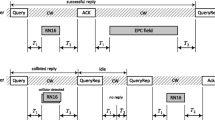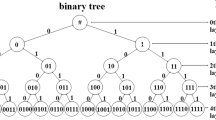Abstract
Since radio frequency identification (RFID) technology has become increasingly common in numerous applications, including large-scale supply chain management, improving the efficiency of RFID tag identification is an important task. In practical settings, the identification of RFID tags often occurs in a dynamic environment, in which tags move through a specific interrogation range. However, the literature contains few studies on the design of efficient identification protocols in dynamic environments. This study proposes a novel tag identification protocol that is particularly efficient in dynamic environments. the proposed protocol involves two anti-collision techniques: adaptive n-Resolution (AnR) and k-Collision Arbitration (kCA). These two techniques significantly improve the tag identification delay and communication overhead. This improvement is primarily due to the use of a newly designed challenge-response bit sequence mechanism and the information obtained from the previous tag identification procedure. As a result, AnR requires only a constant number of interrogation times regardless of the number of target tags, while kCA further improves the efficiency of tag identification with \(k\)-splitting collision arbitration. Rigorous analysis and simulation experiments show that this tag identification protocol significantly outperforms related methods (by at least 48.85 % identification delay and 23.87 % communication overhead can).









Similar content being viewed by others
References
Cheng, T., & Jin, L. (2007). Analysis and simulation of RFID anti-collision algorithms. In Proceedings of 9th international conference on advanced communication technology (pp. 697–701).
EPCTM radio-frequency identification protocols Class 1 Generation-2 UHF RFID protocol for communication at 860–960 MHz Version 1.0.9, EPCGlobal Inc., Dec. 2005.
Floerkemeier, C., & Wille, M. (2006). Comparison of transmission schemes for framed ALOHA based RFID protocols. In Proceedings of international symposium on applications and the Internet workshops (pp. 92–97).
Information technology-radio frequency identification for item management-Part 6: Parameters for air interface communications at 860 MHz to 960 MHz, Amendment 1: Extension with Type C and Update of Types A and B, ISO/IEC 18000–6:2004/Amd. 1:(E), June 2006.
Klair, D. K., Chin, K. W., & Raad, R. (2007). On the suitability of framed slotted Aloha based RFID anti-collision protocols for use in RFID-enhanced WSNs. In Proceedings of 17th international conference on computer communications and networks (pp. 583–590).
Klair, D. K., & Chin, K. W. (2008). A novel anti-collision protocol for energy efficient identification and Monitoring in RFID-enhanced WSNs. In Proceedings of 17th international conference on computer communications and networks (pp. 1–8).
Maguire, Y., & Pappu, R. (2009). An optimal Q-algorithm for the ISO 18000-6C RFID protocol. IEEE Transactions on Automation Science and Engineering, 6(1), 16–24.
Wang, C., Daneshmand, M., Sohraby, K., & Li, B. (2009). Performacen analysis of RFID Generation-2 protocol. IEEE Transactions on Wireless Communications, 8(5), 2592–2601.
La Porta, T. F., Maselli, G., & Petrioli, C. (2011). Anticollision protocols for single-reader RFID systems: Temporal analysis and optimization. IEEE Transactions on Mobile Computing, 10(2), 267–279.
Farooq, M. U., Asif, M., Nabi, S. W., Qureshi, M. A. (2012). Optimal adjustment parameters for EPC global RFID anti-collision Q-algorithm in different traffic scenarios. In 10th International conference on frontiers of information technology (FIT) (pp. 302–305).
MHz-930. (2002). MHz Class 1 radio frequency identification tag radio frequency and logical communication interface specification candidate recommdation version 1.0.1, Auto-ID Center.
Chiang, K. W., Hua, C., & Peter Yum, T. S. (2006). Prefix-randomized query-tree protocol for RFID systems. In Proceedings of IEEE international conference on communications (pp. 1653–1657).
Cho, J. S., Shin, J. D., & Kim, S. K. (2008). RFID tag anti-collision protocol: Query tree with reversed IDs. In Proceedings of 10th international conference on advanced communication technology (pp. 225–230).
Choi, H. S., Cha, J. R., & Kim, J. H. (2004). Fast wireless anti-collision algorithm in ubiquitous ID system. In Proceedings of IEEE 60th vehicular technology conference (pp. 4589–4592).
Choi, J. H., Lee, D., & Lee, H. (2007). Query tree-based reservation for efficient RFID tag anti-collision. IEEE Communications Letters, 11(1), 85–87.
Draft protocol specification for a 900MHz Class 0 radio frequency identification tag, Auto-ID Center, 2003.
Lai, Y. C., & Lin, C. C. (2008). A pair-resolution blocking algorithm on adaptive binary splitting for RFID tag identification. IEEE Communications Letters, 12(6), 432–434.
Lai, Y. C., & Lin, C. C. (2009). A blocking RFID anti-collision protocol for quick tag identification. In Proceedings of the IFIP international conference on wireless and optical communications networks (pp. 1–6).
Lai, Y. C., & Lin, C. C. (2009). Two blocking algorithms on adaptive binary splitting: Single and pair resolutions for RFID tag identification. IEEE/ACM Transactions on Networking, 17(3), 962–975.
Law, C., Lee, K., & Siu, K. Y. (2000). Efficient memoryless protocol for tag identification. In Proceedings of the 4th international workshop on discrete algorithm and methods for mobile computing and communication (pp. 75–84).
Liu, L., Xie, Z. H., Xi, J. T., & Lai, S. L. (2005). An improved anti-collision algorithm in RFID system. In Proceedings of 2nd international conference on mobile technology, applications and systems (pp. 1–5).
Myung, J., Lee, W., & Srivastava, J. (2006). Adaptive binary splitting for efficient RFID tag anti-collision. IEEE Communications Letters, 10(3), 144–146.
Myung, J., Lee, W., & Shih, T. K. (2006). An adaptive memoryless protocol for RFID tag collision arbitration. IEEE Transactions on Multimedia, 8, 1096–1101.
Myung, J., Lee, W., Srivastava, J., & Shih, T. K. (2007). Tag-splitting: Adaptive collision arbitration protocols for RFID tag identification. IEEE Transactions on Parallel and Distributed Systems, 18(6), 763–775.
Namboodiri, V., & Gao, L. (2010). Energy-aware tag anti-collision protocols for RFID systems. IEEE Transactions on Mobile Computing, 9(1), 44–59.
Wang, T. P. (2006). Enhanced binary search with cut-through operation for anti-collision in RFID systems. IEEE Communications Letters, 10(4), 236–238.
Yeh, K. H., Lo, N. W., & Winata, E. (2008). An efficient tree-based tag identification protocol for RFID systems. In Proceedings of 22nd international conference on advanced information networking and applications workshops (pp. 966–970).
Zheng, Y., & Li, M. (2012). PET: Probabilistic estimating tree for large-scale RFID estimation. IEEE Transactions on Mobile Computing, 11(11), 1763–1774.
Zheng, Y., & Li, M. (2013). Fast tag searching protocol for large-scale RFID systems. IEEE/ACM Transactions on Networking, 21(3), 924–934.
Jia, X., Feng, Q., Fan, T., Lei, Q. (2012). Analysis of anti-collision protocols for RFID tag identification. 2012 2nd International conference on consumer electronics, communications and networks (CECNet) (pp. 877–880).
Jia, X., & Feng, Q. (2012). Stability analysis of an efficient anti-collision protocol for RFID tag identification. IEEE Transactions on Communications, 60(8), 2285–2294.
Liang, C.-K., & Lin, H.-M. (2012). Using dynamic slots collision tracking tree technique towards an efficient tag anti-collision algorithm in RFID systems. In 9th international conference on ubiquitous intelligence & computing and 9th international conference on autonomic & trusted computing (UIC/ATC) (pp.272–277).
Schoute, F. (1983). Dynamic frame length aloha. IEEE Transactions on Communication, 31(4), 565–568.
Wieselthier, J. E., Ephremides, A., & Michaels, L. A. (1989). An exact analysis and performance evaluation of framed aloha with capture. IEEE Transactions on Communication, 37(2), 125–137.
Capettanakis, J. I. (1979). Tree algorithms for packet broadcast channels. IEEE Transactions on Information Theory, 25, 505–515.
Mosely, J., & Humblet, P. (1985). A class of efficient contention resolution algorithms for multiaccess channels. IEEE Transactions on Communication, 33(2), 145–151.
Finkenzeller, K. (1999). RFID handbook: Radio-frequency identification, fundamentals and applications. New York: Wiley.
ISO/IEC 14443. Inentification cards—Contactless integrated circuit cards—Proximity cards.
ISO/IEC 15693. Inentification cards—Contactless integrated circuit cards—Vicinity cards.
ISO/IEC 18000. ISO/IEC 18000 Information Technology AIDC Technologies—RFID for item management—Air interface.
Acknowledgments
The authors gratefully acknowledge the support from the Taiwan Information Security Center (TWISC) and the National Science Council, Taiwan, under the Grants nos. NSC 102-2218-E-259-004, NSC 102-2218-E-146-002, NSC 102-2218-E-011-012, and NSC 102-2218-E-011-013
Author information
Authors and Affiliations
Corresponding author
Rights and permissions
About this article
Cite this article
Yeh, KH., Lo, NW., Tsai, KY. et al. A Novel RFID Tag Identification Protocol: Adaptive \(n\)-Resolution and \(k\)-Collision Arbitration. Wireless Pers Commun 77, 1775–1800 (2014). https://doi.org/10.1007/s11277-014-1608-3
Published:
Issue Date:
DOI: https://doi.org/10.1007/s11277-014-1608-3




